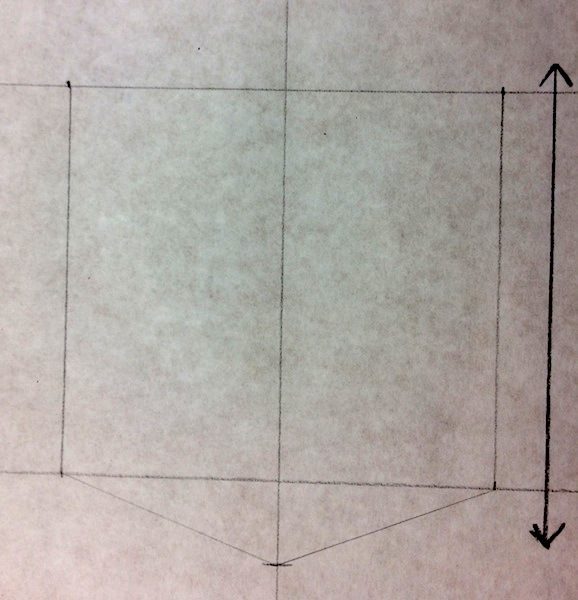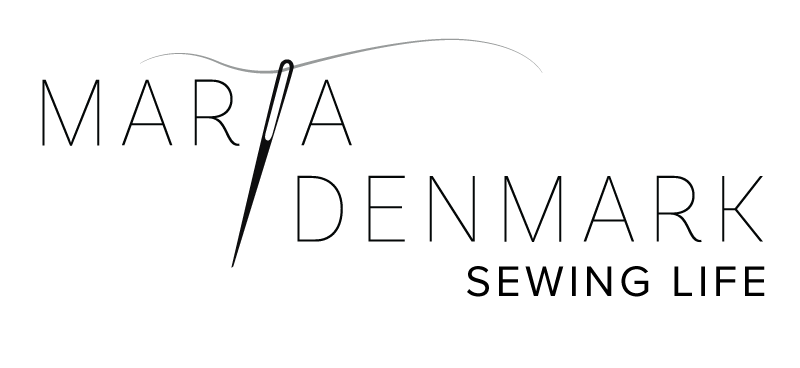Johanne (or Jo, s she likes to be called in English) is interning at MariaDenmark at the moment. She has a very different core style from mine and loves to have a lot of details in her clothes. So I asked her to write a blog post on how to make your basic tops more interesting. One of the ways to do that, is to add a breast pocket, with or without extra trimmings. Du can use this technique on tank tops, loose-fitting tees and on close fitting tees. I am inspired to try this on my next basic oversize tee. Enjoy Johanne’s tutorial:
Basic t-shirt with a pocket
Written by Johanne, the MariaDenmark intern
You start off with your basic t-shirt. I’ve chosen 102 Birgitte Basic T-shirt with a rounded neckline.
I have changed my pattern by raising the neckline on the front. This way I’ve got more room for the pocket.

How to change the neckline:
Start by elongating your centre-front line. Choose the length you want. I’ve chosen 5 cm (2”)

Now draw a new neckline curve.

Now you need to make sure, that the new front neckline curve works with the curve of the back neckline.
When you have traced the back of your t-shirt, cut the paper at the shoulder. Place the pattern pieces shoulder to shoulder. and check if the curve is smooth.

If it doesn’t look right, correct the curve, so it looks right.

How to draft the pocket:
Now it’s time to draft your pocket. It’s a good idea to draft it right on the front of your t-shirt pattern. This way, your pocket will be the right size.
Begin by drawing two lines with a perpendicular to your centre-front line. This will be the height of the pocket square.
Now decide where the center of your pocket will be placed, and draw a line to indicate this. (This is on a 90 degree angle of the two original lines)

Measure outwards to find the width of the pocket. I’ve chosen 5 cm (2“) on each side, and 2 cm (¾”) downwards to complete the pentagon.

Now we need to add seam allowances to the pocket.
Add 1,5 cm (⅝”) seam allowance to the top of the pocket. You’ll need more at this edge because this will be folded over twice.
Add 1 cm (⅜”) seam allowance to the remaining sides of the pocket.

The grainline of your fabric is indicated on the pattern by a double headed arrow.
I’ve chosen a striped fabric, and I want to turn the pattern 90 degrees. This is possible because my fabric is stretchable both horizontally and vertically.

Cut the pocket from your fabric and fold and press 0,5 cm (¼”) of the top under.

Tip: If your fabric easy to press, proceed to fold it another 1 cm(⅜“) and press this; a total of 2 folds. This way, you will not have to stitch this part twice.
I have however chosen to stitch the first 0,5 cm(¼”). Afterwards, I fold and press 1 cm (⅜“). Now I sew 8 mm (⅓”) from the top.

Now the top part of your pocket is finished and you have reached the point of shaping your pocket.
As an quick and easy way to press the seam allowances down, place your pocket pattern (without seam allowance) on a piece of cardboard and cut it out.

Place the cardboard template on top of your pocket and press the seam allowances under.
To get the edges really sharp, remove the cardboard and continue to press the pocket until it lies flat.

Placing the pocket
For better visual content, I have chosen to sew my t-shirt before placing the pocket on it. But it is far easier to stitch the pocket to the front piece before sewing the t-shirt. This way you will not have the trouble of turning the entire t-shirt inside your sewing machine.
Place the pocket on your t-shirt. Maybe you’ve thought of a better placement, and at this stage it is easy to get a view of different versions of the final product.

Pin the pocket in place on the front of your t-shirt.
Sew the pocket in place by edgestitching it in place 3 mm from the edge.

You’ve got your finished pocket t-shirt!
There are so many different choices for pockets. In the next blog post I will show you how to sew rounded pockets and pockets with a trim.
Enjoy!







Thanks for these ideas. You really have got me thinking about exactly what I need to make. I’ve started a notebook to record my thoughts as I source fabrics and adapt a pattern I already have. I’ve made long sleeved polo neck tops for winter before now, but need something lighter for the warmer weather. Thanks so much!
Beautiful idea! Thanks for sharing tutorial to make more for us.